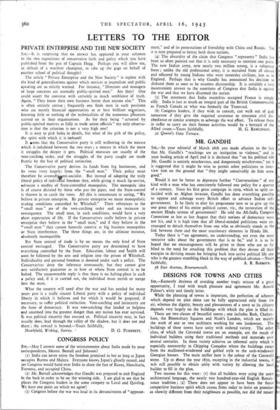DESIGNS FOR TOWNS AND CITIES
Spry—Earnestly desirous of avoiding another tragic misuse of a great opportunity, I read with much pleasure and agreement Mr. Arnold Palmer's witty and timely letter.
While the planning of towns is important, the perfection of schemes which depend on plan alone can be fully appreciated only from the air, whereas the dignity, beauty and pleasantness of a town to its citizens depends very largely on the buildings with which the plan is filled in.
There are two classes of beautiful towns ; one includes Bath, Chelten- ham, the Bloomsbury Squares and Nash's London, which are mainly the work of one or two architects working for one landowner. The buildings of these towns have unity with ordered variety. The other class, of which the Cotswold towns are an example, are the result of Individual builders using their traditional methods and materials over several centuries. In these variety achieves an informal unity which is especially noteworthy in Chipping Campden where the buildings range from the mullioned-windowed and gabled style to the sash-windowed Georgian houses. The main unifier here is the colour of the Cotswold stone. Up to about the year 185o, excepting in the industrial towns, it was still possible to obtain unity with variety by allowing the local builder to fill in the plan.
Two reasons for this were: (t) that all builders were using the same architectural language, the nearly two hundred-year-old English Renais- sance tradition ; (2) There does not appear to have been the fierce competitive business spirit which causes firms today to insist on premises as showily different from their neighbours as possible, nor did the' tenant of a house expect more from its exterior than plain well-proportioned sound building with, perhaps, a touch of elegance in a doorway.
From the late nineteenth century, and especially since 1918, competi- tion between speculative builders has exploited the sentimental love of "quaintness " in clients absolutely without any standards. The purchaser, and his wife, knows what he wants in plans and interior fittings, appreciating simplicity and efficiency, but is absolutely at sea, being without equipment or training, in judging the comparative qualities of exteriors themselves and in relation to each other. In consequence the builder " prettifies " his houses to make them, as he believes, saleable by placing purposeless sham timber gables over the bay windows of bungalows, cheap leaded lights in windows and front doors, breaking up the wall space of Anal houses by rough-casting the upper storey. While some of the new materials are pleasant in colour such as the soft- coloured red bricks now made, many are harshly coloured and often appear to have been used because of their unsuitability to the district, for example red roofs among the North Lancashire and Westmorland fells.
Mr. Palmer's suggestion that designs should be supplied by architects for the guidance of local authorities is good, but it would not touch the buildings I have described unless the local authorities had power to control and veto the designs of elevations. In some districts such as the Lakes there are advisory panels of architects, but I do not know how far it is compulsory to use them. So far as I have seen the housing estates designed by local authorities they are infinitely better than the enormous mass of private building since the last war which is mainly responsible for the ribbon development and the houses and bungalows sprinkled over the countryside and the most popular stretches of our coat.
While granting the superiority of inter-war houses over those built for nineteenth-century wage-earners, their main defect is the monotony of equal-sized boxes with pyramidical roofs.
Recognising that the old haphazard growth of towns by individual builders each developing their own plots of land as seemed most profit- ble to themselves is obsolete, we ought to realise on the other hand that worthy towns are not created by merely enforcing cast-iron by-laws ollowing fetishes of all houses detached or semis, so many houses to acre, &c. A well-designed town is a work of art created by two three architectural minds, knowing the needs of the future citizens, orking on land under single ownership with full control of the materials o be used and discretionary powers to vary the application of by-laws or special reasons so that some houses could be built in groups or rraces, including houses of varying sizes, and providing for public uildings and necessary amenities. The building could, of course, be 'ed out by private firms.—Yours truly, T. A. CLARKE. 20 Glen Eldon Road, Lytham St. Annes, Lana.



























 Previous page
Previous page